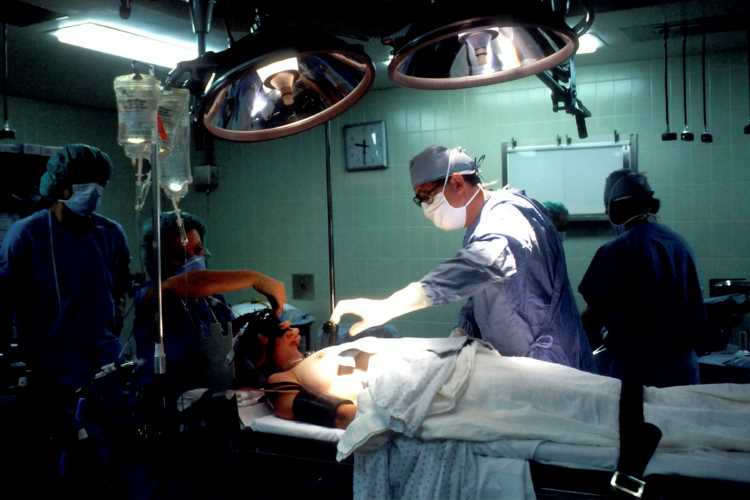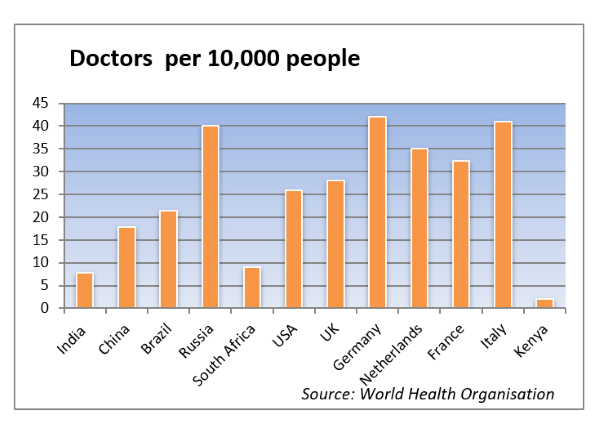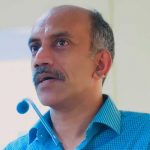
The new coronavirus outbreak has exposed the chinks in India’s healthcare system. States with better public health facilities did well in containing the spread of Covid-19, laying bare the lack of attention given to the sector by the others. According to the 2019 figures of the Medical Council of India, the country has 12,01,354 registered doctors practising modern medicine for its population of more than 130 crore. India is among the 45% of the World Health Organisation members that fall short of its requirement of one doctor per 1,000 people.
According to WHO estimates, India has eight doctors per 10,000 people, while the UK has 28 and the US has 26. China, with a comparable population to India, has 18 doctors per 10,000 people. The numbers for India are misleading. A few of states in the south (Tamil Nadu, Karnataka, Kerala and Goa), the doctor to population ratio is higher than the WHO stipulation. While UP and Bihar has one doctor per 3,000 people, the figures for the north eastern states such as Mizoram and Nagaland are far worse. These states do not have a doctor per 15,000 people.

While the WHO mandates 40 nurses/midwives per 10,000 people, India has 17 and China has 27. The figures of Bihar and Uttar Pradesh are abysmally bad. Prejudices nurtured towards this profession have seriously hampered healthcare delivery in these states. It is unfortunate that it takes a pandemic to force an assessment of the strengths and weaknesses of our healthcare apparatus. The government should seriously think in terms of a national skills upscaling mission that could enlist volunteer apprentices with secondary education. The country must have a ‘train-as-they-earn’ programme for addressing the shortages in the healthcare sector.
READ: Eight factors behind Kerala’s successful Covid-19 response
The Sixth Pay Commission has significantly increased the pay and allowances of nurses, making the profession more attractive. Over the last two decades, ageing populations in advanced economies have further bolstered the demand for nursing services globally. Despite all of this, the wages of nurses and midwifes in the unorganised sector leave much to be desired. Even now, a large share of the nursing workforce in India comes from the southern states. The fillip received from the enhanced pay and allowances has resulted in the entry of more men into the nursing workforce. It has also resulted in the emergence of unionisation among nurses, resulting in higher wages in the sector.
Though the advanced economies in Europe have a high doctor to population ratio, ranging from 20 per 10,000 people to 42, it has been achieved through migration of doctors from developing economies. In the light of the pandemic, the United States has already hinted at liberalising the rules governing the immigration of medical personnel. It has decided in principle to increase the quota of health professionals in H-1B visas.
READ: Odisha’s quiet success in war on Covid-19 pandemic
Similar moves are underway in the UK too for addressing the chinks in the National Health Service. One of the earliest acknowledgement of the role played by overseas doctors towards upscaling National Health Service in Britain came from a debate in the House of Lords way back in 1961, when Lord Cohen of Birkenhead commented that the National Health Service in Britain would have collapsed had it not been for the influx of junior doctors from India and Pakistan. Enoch Powell, the minister of health, who oversaw the expansion of NHS in 1960s, resorted to this strategy probably because of his familiarity with India during his tenure in the British Army. A 2001 study had estimated that there were at least 60,000 doctors of Indian origin in the UK, which amounted to around 12% of the total stock of doctors in India and about 30% of the registered doctors in Britain.
Policy makers in developing countries should be cautious of the growing possibility of poaching of medical personnel by advanced economies. A ban on emigration of doctors would not work as the salaries of doctors in these countries are far higher than their earnings back home. Possibly, Jagdish Bhagwati’s argument in favour of a brain drain tax should be given a relook. Bhagwati had suggested that a small share of the taxes levied on these skilled professionals should be send to their country of origin. This would go a long way to compensate those sending economies for the expenditure they have incurred on nurturing the talent.
READ: An invisible crisis: People living with HIV in times of Covid-19 pandemic
There are a number of studies that reveal a tendency among sending countries to further increase the supply of doctors and nurses. In the case of India, we find that from in the states that saw large-scale migration of medical and nursing personnel, there has been a growth in new entrants into the profession. And states like Kerala and Karnataka have the best doctor per population ratios among all states despite the emigration. Therefore, the efforts of the central and state governments should be to incentivise and enhance accessible medical education in the public sector with a few years of compulsory service.
(Krishnakumar S teaches economics at Sri Venkateswara College, University of Delhi.)
Krishnakumar S is a New Delhi-based economist. He teaches economics at Sri Venkateswara College, University of Delhi.


